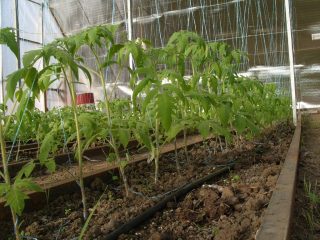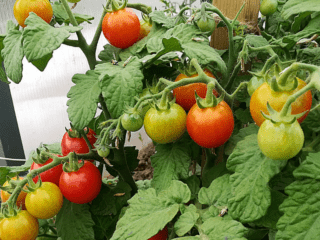Content
White spots on tomato seedlings often appear due to non-compliance with care rules. For example, they can be caused by excess light, temperature changes, and frost. Often white spots are formed due to fungal or viral infections. The main causes, ways to solve the problem and preventive measures are described in the article.
Why do the leaves of tomato seedlings turn white?
There are various reasons for the appearance of white spots on tomatoes. They are often associated with diseases that cannot be completely excluded. But it also happens that the seedlings are quite healthy, although extraneous specks still form. The most common causes of this phenomenon are described below.
Lack of microelements

White spots on tomato seedlings also form due to poor nutrition or depleted soil
If the soil is extremely low in iron, some leaf blades will turn yellow in the area between the veins. If there is too much manganese, the entire bush becomes covered with brown spots.
Since it is not always possible to accurately determine the excess or deficiency of a particular element, you should feed tomatoes with complex fertilizers that contain all the essential microelements. In addition, for planting seedlings and adult seedlings, it is necessary to prepare the soil by fertilizing it with organic matter and mineral fertilizers.
Sunburn

White spots on the leaves of tomato seedlings often appear due to sunburn
Plants really need light, but an excess of scorching rays is no less harmful than a deficiency. Similar phenomena are especially often observed if tomatoes are transplanted into a greenhouse.
As a result, the foliage becomes covered with numerous white, whitish spots, the seedlings stop growing and may even die. Sunburn also appears on seedlings that have not undergone a preliminary hardening procedure.
Very rarely, white spots appear on tomato seedlings when grown on a windowsill. If the sun is too bright, it is better to set the containers a little further away or shade them with white fabric, mesh, organza or tulle.
Frostbite
If the leaves of tomatoes turn white after planting, and the weather is still cool outside, the reason may be due to frostbite.

After transplanting into open ground, white spots on tomato seedlings may appear due to low temperatures
Tomatoes are a demanding crop, and temperature drops to +10OC already leads to negative consequences. If the difference is quite strong, and the seedlings did not undergo the hardening procedure the day before, the risk increases significantly.
Powdery mildew

If white spots appear on tomato seedlings, this may also indicate a disease such as powdery mildew.
The main symptom is the appearance of a coating on the plates, somewhat reminiscent of flour. It can be either white or grayish.
The colony infects the bush from bottom to top. As a result, the seedlings dry out and some plants wither. The fungus usually appears in conditions of high humidity and heat.
Cladosporiosis

A dangerous fungal infection is cladosporiosis.
As a result of the damage, not only white but also yellowish spots appear on the foliage of seedlings. Moreover, after a few days they turn brown. If you examine the plates from the back, you will also notice brown spots on them, and they are velvety to the touch.
Septoria
White spots on tomato seedlings also appear due to septoria. This is a fungal infection that causes damage to foliage. The plates are covered with small specks (up to 0.5 cm) and gradually grow.
In the center they are light, and at the edges they become dark. Sometimes a brownish dot appears in the very center.

The main cause of septoria is heat and excessive watering - such conditions are often created in a greenhouse
Mosaic of tomatoes
When the leaves of tomato seedlings turn white, this may also indicate a viral infection. The most common is mosaic - it can affect both tomatoes and other crops, for example, cucumbers, potatoes, and eggplants. Main signs of pathology:
- the appearance of a pale, bright yellow or rich green color on the leaves and stems;
- withering;
- loss of elasticity;
- uneven growth of parts of leaf plates and, as a result, the appearance of folding.

The mosaic appears as white and yellow spots
Therefore, after transplanting into open ground, the bushes should be periodically inspected and, if necessary, treated with folk remedies or insecticides.
White rot

White rot is a fungal infection that causes spots on tomato seedlings
Problem areas often appear not on the foliage, but on the stems. Moreover, they begin to rot, mucus is released from them, and soon after this the plant dies. The disease develops especially often in conditions of high humidity and coolness.
Late blight

Late blight is a very common disease of tomatoes and many nightshades (eggplants, peppers, potatoes)
A fungal infection, depending on the form of development, can lead to the death of shoots and “burn” of leaves. In this case, the general signs of pathology are:
- brown-gray, white spots on tomato seedlings;
- cobweb-like plaque;
- white mold.
Fungal spores develop well in high humidity and high temperature conditions. Often the appearance of the disease is provoked by planting seedlings too close or lack of ventilation.
What to do if the leaves of tomato seedlings turn white
First of all, it is necessary to determine the reason why the white spots appeared. This is not always easy to do - it is necessary to study the symptoms of various diseases, compare them with photos, and also evaluate the growing conditions. As a rule, white spots on seedlings appear due to improper care:
- excessive watering;
- lack of ventilation;
- temperature changes;
- sudden cold snap;
- insufficient feeding.

To diagnose the cause of white spots, you need to carefully examine the plants and study the growing conditions.
Therefore, first of all, it is necessary to create suitable conditions. You should also follow a few rules:
- Seedlings require frequent, but not too abundant watering. When the seeds are just planted, the surface of the soil is sprayed with water daily. But if the seedlings have already appeared, they need to be watered in the “every other day” mode. It is important to ensure that the soil does not become waterlogged. This will help prevent the appearance of white spots.
- When growing tomato seedlings in a greenhouse, it is necessary to ensure regular ventilation. At home, you also need to ventilate the room, but first take out the boxes with seedlings so that they do not suffer from a draft (if it is cold outside).
- To prevent the appearance of white spots on tomato seedlings, when growing, you need to fertilize in a timely manner. It is best to take a ready-made mineral composition, for example, “Ideal” or “Agricola”. Fertilizers are given after 2-3 leaves appear, a week after picking, and then after transplanting to the garden bed.
- If signs of any disease appear, affected seedlings should be planted away from healthy ones. It is necessary to disinfect the soil, for example, with a weak solution of potassium permanganate. It is worth keeping in mind that while fungal infections (for example, late blight, cladosporiosis) can be cured, viral infections (mosaic) certainly cannot. In this case, the affected seedlings must be destroyed.
- To treat and prevent fungal infections, treatments are carried out with Bordeaux mixture or other fungicides, for example, “Skor”, “Maxim”, “Ordan”. To prevent the appearance of white spots, another spraying should be done after transplanting tomato seedlings.
- The soil for sowing tomato seeds and seedlings in open ground or in a greenhouse must be loose and fertile. First, humus or compost is added to it - 5-7 kg per 1 m2. To sow seeds, take universal soil or make it up from turf soil, black peat, humus and sand (ratio 2:1:1:1).

To prevent white spots from appearing, it is important to observe the watering norm and apply fertilizing in a timely manner.
Preventive measures
Preventing the appearance of white spots on tomato seedlings is easier than dealing with the consequences. Therefore, it is necessary to follow simple preventive measures that will allow you to grow healthy bushes. Experienced summer residents recommend adhering to several rules:
- Do not plant tomatoes too close - after 3-4 leaves appear, the seedlings are picked. When planting in open ground, no more than 4-5 bushes are placed per 1 square meter (if they are large and tall - a maximum of 3).
- Two weeks before transplanting tomato seedlings into open ground, they begin to harden them. To prevent white spots from appearing, the plants are taken out onto the balcony or into the open air, first for a few minutes, then gradually increase the time. On the last day, they are left to spend the night in a cool place at a temperature of 15-17 degrees.
- To prevent diseases, seeds should be treated, for example, kept in a solution of Fufanon or potassium permanganate for 30 minutes.
- To ensure that there are no white spots or signs of other diseases on tomato seedlings, the soil is also disinfected. To do this, put it in the freezer for several days or spill it with a solution of potassium permanganate (1 g per 1 l).
- When growing in a greenhouse, it is important to create shading, since the transparent walls allow too much sunlight into the room. It will not be superfluous to periodically inspect the plants, and if white spots appear on the tomato seedlings, treat them with preparations or apply fertilizing with complex fertilizers.
Conclusion
White spots on tomato seedlings are a clear deviation in growth, which can lead to withering and even death of the seedlings. In such cases, it is recommended to create suitable growing conditions and determine the cause as quickly as possible. Just in case, it is worth replanting the affected plants so that they do not infect healthy tomatoes.








